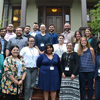For all of the hand-wringing about the lack of tenure-track jobs, graduate faculty often seem indisposed or ill-equipped to prepare their students for jobs outside of higher ed. Faculty who train graduate students must prepare students for multiple career paths by focusing not just on developing students’ intellectual engagement with the historiography or research tools, but by also introducing them to history career paths broadly construed. Building these paths into our teaching is one powerful way to signal to our students that there are multiple ways of being a historian.

Graduate students in Courtney E. Thompson’s classes select their own assignment paths to develop skills directly applicable to their professional goals. Justin Luebke/Unsplash
When I planned my first graduate-level course, I dutifully assigned the expected historiographic paper. Although my students produced great work, the essays were uniform and lacked vibrancy. I realized that this kind of assignment had limited utility. First, many graduate students were ill-equipped to write a historiographic essay. But second, and more importantly, writing a historiographic essay only really taught them how to write historiography—not a bad skill to have, but redundant if they were doing the same in other courses. I wanted to develop a pedagogical approach that would provide my students with tools that they could apply in their other courses and beyond the classroom. This seemed particularly important since I teach in a program with both MA and PhD students, who come to the classroom with varied experiences and professional goals. While some hope to be hired as tenure-track faculty, others are looking at career paths that lead into high schools, museums, libraries and archives, or other sites and fields. I began to consider how I could help these students by focusing on transferable skills, demonstrating how knowledge of the field and historical research skills can serve as a foundation for various forms of historical work for different audiences.
Over the next few years, I experimented with various assignments and assignment structures in my graduate courses, using student feedback to redesign these assignments for the next graduate course. But I was still unsatisfied. It seemed as silly to ask a roomful of graduate students whose professional aspirations did not include major independent research projects to write a fellowship application as to write a historiographic essay. And with every new class, I had more assignment options to draw from, which became harder and harder to choose between. I hit upon the solution: Why not let them choose?
And so my interpretation of the “Choose Your Path” assignment structure was born, first tested in my History of the Body colloquium during the fall of 2020. I decided there would be three key assignments, which would feed into one another. After an initial annotated bibliography project—thus foregrounding historiography and using it as a stepping-stone, rather than treating it as an end point—each student would pick a “path” through which they would complete the other two projects, which were scaled to be more or less the same amount of work. The three paths I settled on were pedagogy, research, and public engagement, though I considered other options and plan to expand this decision tree further in the future.
I hit upon the solution: Why not let them choose?
All students begin the assignment path with an annotated bibliography that becomes the foundation for their further projects. While they shared in the experience of completing an annotated bibliography, their topics were wide-ranging and specific to their own research interests, as I encouraged them to find topics and materials that were relevant to both their short-term and long-term goals. After this point, they selected a path and began work on the second project, which was either a new course proposal and syllabus (pedagogy), a fellowship application (research), or a pitch and op-ed (public scholarship). After the second assignment, they moved on to the third major assignment, building once again from the research and materials from the first two: a lecture draft and presentation (pedagogy), an annotated document and primary source analysis (research), or an exhibition proposal and design (public scholarship). Each of these assignments had multiple components and instructions, some borrowed from past courses, and some (the public scholarship track) were invented wholesale for this assignment.
Since each assignment built on the previous one and all were founded on close attention to historical literature, the varying products demonstrated the centrality of research and scholarship to all branches of history for various audiences and in different venues. The assignment structure puts into practice James Grossman’s recent call to expand the boundaries of our definition of scholarship (“The Diffusion of Knowledge,” Perspectives, January 2021). As he observed, “As we broaden the terrain of our work, we correspondingly widen the appeal of our discipline to individuals interested in history but also committed to influence beyond the academy, whether from within the professoriate or beyond.” The basic tools of research can and should be presented as a foundation for different kinds of historical labor for different audiences, broadening students’ conception of what history is and where and how it is done through different formats. As Grossman explained, this kind of work helps us “prepare graduate students for the many ways of being historians.”
The three paths were selected based on my own experience and skill sets, as I believed myself capable of assessing and guiding students through this work. This could be seen as a limitation. While I’ve designed exhibitions, for example, my experience (and the assignment) was still heavily reliant on traditional academic research. Other forms of public engagement and scholarship are beyond my own current skill set; indeed, it wasn’t until I assigned a pitch and op-ed (and developed corresponding guidelines) that I was emboldened to start doing the same. In future iterations, I hope to bring in campus experts in fields including archival management, exhibition planning, and digital scholarship to expand the options and train my students (and me) in developing these projects. Such cross-campus collaboration, while not incorporated into my course design this past fall, is a goal for my graduate pedagogy in the future.
I was up front with my students about the fact that this was an experimental design. The assignment structure thus became an open conversation about how we develop assignments and the goals of graduate coursework, which provided us with another set of lessons and further transparency about what history is and how it is done. At the end of the semester, they provided me with useful suggestions about how to revise this structure for the future, including adding “mini-orals” presentation components, digital humanities options, and other possible assignments.
While a simple idea at heart, this assignment structure conveys some key notions to students.
Since this course assignment design is iterative and interactive, in the future I hope that it will look less like a set of narrow tracks and more like a branching tree of options and decisions, with each branch relating to a set of skills and a professional path or paths. I also intend in future iterations of this assignment to incorporate concepts and resources from the AHA’s Career Diversity for Historians initiative. The “Career Diversity Five Skills,” for example, could be used as a starting point for five branching assignment paths. The resources available as part of this initiative might also provide students with a starting point for articulating their long- and short-term goals, which in turn could allow me to create assignment paths and options for them to respond to their needs.
While a simple idea at heart, this assignment structure conveys some key notions to students. First, it encourages them to think of history as an applied field with different professional pathways, products, and audiences. When one also incorporates ongoing discussion of professionalization and five-year plans, as I did in this course, it helps students think actively about their engagement with history and their pursuit of a professional path, rather than treating it as a passive set of developments one falls into. Second, treating these three (or more) paths as co-equal sends a strong signal that there is not a “Plan A” and “Plan B,” but that there are a number of equivalent professional paths open to someone with an advanced degree in history. Third, it also responds to student needs and goals. If an MA student has a clear goal of becoming a primary or secondary school teacher post-degree, why not provide them with tools now that can be applied later, by demonstrating how historical theory and methodology can and should inform course design at every level?
Of course, a flexible assignment structure cannot solve all of the discipline’s challenges. But perhaps such structures will force both faculty and students to confront the realities facing history graduate students, helping to both acknowledge and legitimize their goals. If students are equipped for multiple paths through the development of multiple skill sets, and these possible paths are treated as equally valid and valuable, perhaps this would be a small step away from the idea that we ought to “fix” the jobs crisis and toward reframing who historians are, what they do, and what paths they take.
To view the complete assignment discussed in this article, please visit the AHA's Career Diversity Faculty Resources page.
Courtney E. Thompson is an assistant professor at Mississippi State University. She tweets @Dr_C_Thompson.
Tags: Features Career Diversity for Historians Teaching & Learning Graduate Education Teaching Resources and Strategies

This work is licensed under a Creative Commons Attribution-NonCommercial-NoDerivatives 4.0 International License. Attribution must provide author name, article title, Perspectives on History, date of publication, and a link to this page. This license applies only to the article, not to text or images used here by permission.
The American Historical Association welcomes comments in the discussion area below, at AHA Communities, and in letters to the editor. Please read our commenting and letters policy before submitting.
Comment
Please read our commenting and letters policy before submitting.










